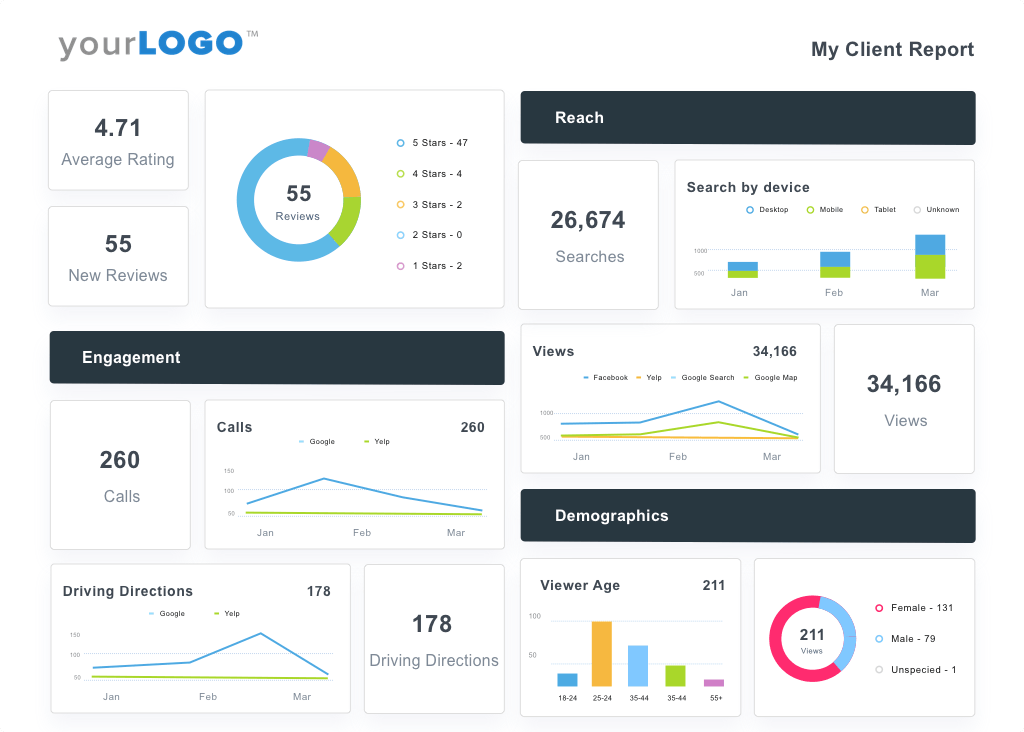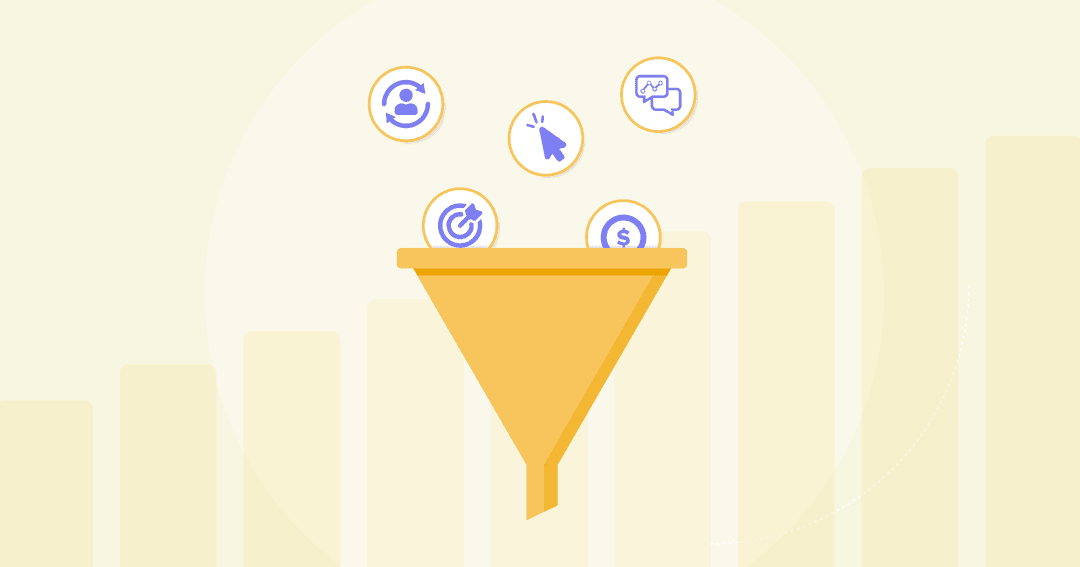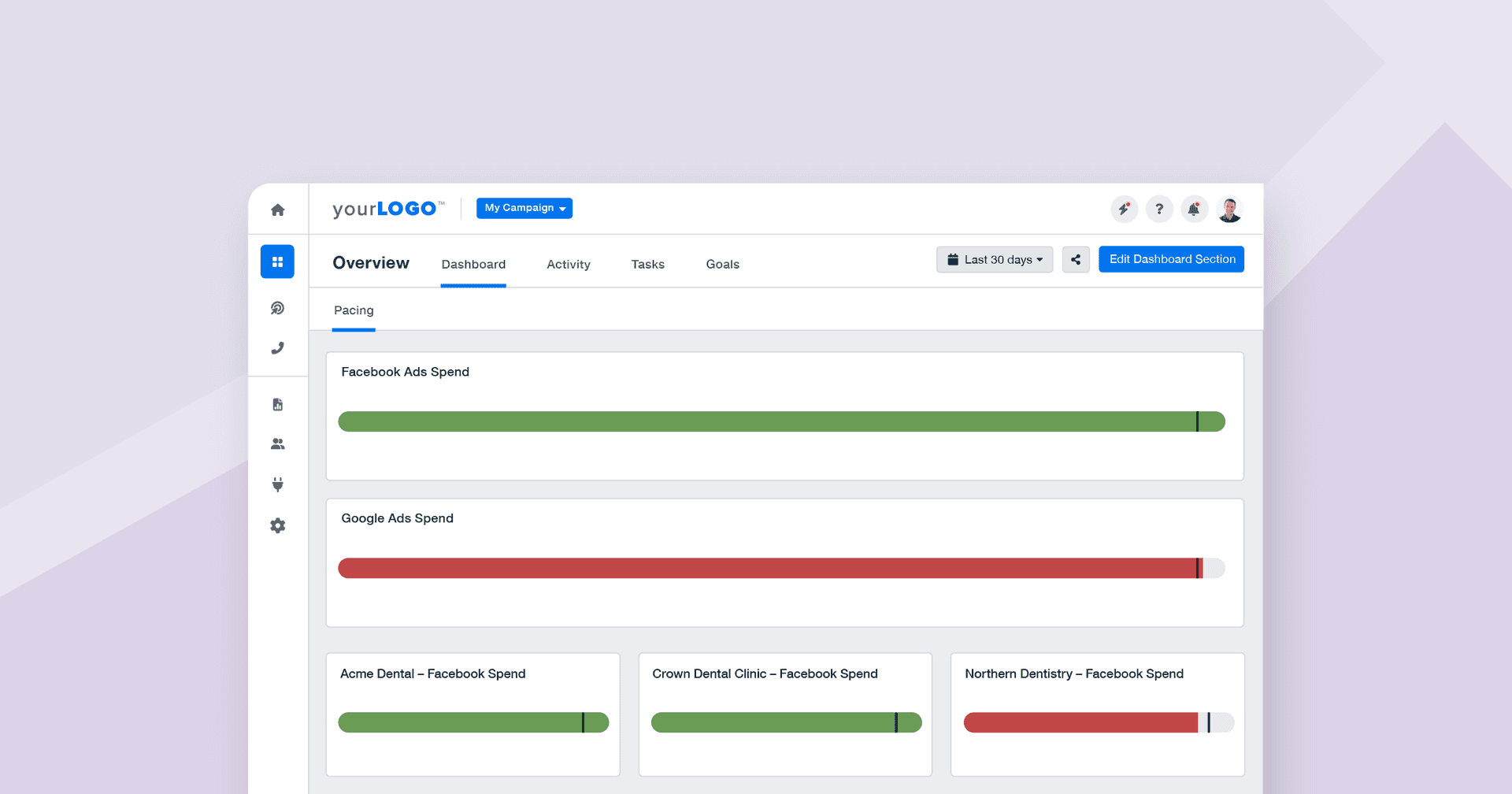Table of Contents
Table of Contents
- Is Performance Tracking the Same for B2B and B2C Businesses?
- 4 Key Conversion Metrics To Track for Both B2B and B2C
- What’s Different With B2B vs. B2C Conversion Metrics?
- 3 Conversion Metrics to Improve Your B2B Campaigns
- 6 B2C Conversion Metrics to Track To Improve Campaigns
- Conversion Metrics To Highlight in PPC Reporting
- Conversion Metrics To Highlight in Ecommerce Marketing
- Using Conversion Metrics To Improve Client Campaigns
7,000+ agencies have ditched manual reports. You can too.
Free 14-Day TrialQUICK SUMMARY:
Conversion metrics are specific measurements that track how effectively a marketing campaign leads to desired actions, such as sales, sign-ups, or downloads. These metrics are crucial for a marketing agency to evaluate marketing efforts, campaign success, and ROI, guiding strategy adjustments and client reporting. Here are the most important conversion metrics to focus on.
With so much data at our fingertips, tracking it is easy with automation software. But often, the issue isn’t just about how to track your client’s metrics, it’s about what you need to keep an eye on to ensure successful campaigns. Your clients hired your agency to track what matters and help them translate the numbers into actionable business insights that will help drive them forward.
That’s where conversion metrics come into play.
Let's explore the key conversion analytics to track for different types of clients, how to make the most of them, and how to combine all that data into a comprehensive picture that your clients and their sales teams will understand.
Is Performance Tracking the Same for B2B and B2C Businesses?
Both B2B (business-to-business) and B2C (business-to-consumer) companies employ certain universal Key Performance Indicators (KPIs) to evaluate their progress. This alignment of metrics across both sectors reflects the core objectives that all businesses share in monitoring success, regardless of whether they target individual consumers or other businesses.
When managing performance tracking for either B2B or B2C clients, your agency should consider the following essential metrics as foundational elements of your tracking strategy:
Website Traffic: Understanding visitor flow and behavior on your website.
CPA (Cost per Acquisition): Measuring the cost-effectiveness of converting prospects into customers.
Sales Conversion Rate: Analyzing the percentage of visitors who complete a desired action, such as making a purchase.
ROI (Return on Investment): Evaluating the profitability of investments in marketing campaigns and other business activities.
ROAS (Return on Ad Spend): Assessing the revenue generated relative to the amount spent on advertising.
These shared metrics provide an essential framework for assessing performance and guiding decisions in both B2B and B2C contexts, reflecting the universal principles of effective marketing and business management.
4 Key Conversion Metrics To Track for Both B2B and B2C
Let's explore four key conversion metrics that are instrumental in enhancing both B2B and B2C campaigns–and show you what to do with them.
1. Website Traffic and Traffic Sources
As an essential part of your customer journey, tracking website traffic over time will show how you’re increasingly driving potential customers to your clients’ business. But it’s also important to monitor Traffic Sources to see which sites drive more website traffic.
Google Analytics (GA4) reporting tools have a lot of data available. But as an agency that tracks this data at scale for each client, you'll need a live dashboard to do it efficiently. There are too many critical GA4 metrics to track manually for each and every client.

Use a Google Analytics dashboard to get live data to a visual dashboard automatically. Try it free in AgencyAnalytics for 14 days.
Look at:
Direct traffic: These are website visitors that come to your client’s website directly by typing their URL in their browser’s address bar
Search traffic: Visitors that find your client’s website through a search engine
Referral traffic: Visitors that find your clients by clicking a link to their site from another page–i.e., Social media bio, another website, etc.
Paid traffic: It is essential to highlight PPC performance metrics on platforms like Google Ads if your agency is handling the client’s paid advertising campaigns, but even if you are not, this helps add context to the rest of the numbers.
Each has different engagement rates, so tracking them all individually is good. And just as in investing, it’s essential to diversify your traffic sources. If you’re relying too heavily on search traffic when Google makes a change to its algorithm, you could lose all your client’s website visitors in one go.
This is why agencies need an all-in-one client reporting platform that pulls in data from 80+ diverse marketing platforms. This way, you automatically track all your clients' key metrics under one roof.
2. Bounce Rate
The bounce rate, or abandonment rate, is essentially the opposite of conversions. Keep bounce rates low and look at the Exit Pages or Bounce Rate in Google Analytics to see where you can make improvements to reduce your bounce rate. Here are some tips to reduce bounce rates to help you assess the breaks in the sales process. Or check out our website performance metrics to track even more for your clients.
Read More: Google Analytics metrics to track.
3. Conversion Rate
One of the most important metrics and one your clients care about when it comes to web analytics. Conversion rates mean different things on each platform and for each business–see Micro Conversions.
A conversion rate is loosely defined by the action you want a visitor to take. While it is usually related to profit, it can be:
Revenue-based conversions - i.e., signing up for a paid subscription (SaaS), purchase or order completion
Lead acquisition conversions - i.e., signing up for a freemium membership, completing an application form
Inquiry conversions for websites without eCommerce - i.e., direct phone calls, submitting contact info for follow-up, or requesting a quote
Whatever the conversion is, it’s important to highlight how you're reaching your clients' goals in your reports.

Integrate goal-tracking into your agency's workflows. Keep tabs on your client campaign progress and easily report your success. Discover a host of features when you sign up for your free 14-day trial with AgencyAnalytics.
4. Product Relationships
Knowing what products or services go well together will help increase conversion rate and AOV, boosting sales and revenue. Product relationships are all about connecting products and services with each other. For instance:
Creating product bundles
Suggesting similar or complimentary products, i.e., “You might also like”
Aligning product suggestions with the customer, i.e., “Customers also bought”

Amazon is probably the king of ‘Similar Products.’ Look up ‘waterproof speakers’, and they suggest not only nearly identical products, but also products bought together, and similar products in the category. Test out different combinations of product relationships and see which ones get the most engagement.
What’s Different With B2B vs. B2C Conversion Metrics?
While some B2B and B2C conversion metrics overlap, the success of each type of campaign is ultimately defined differently. Business type and size affect business goals and definitions of success, prioritizing different conversion metrics. Also, B2B and B2C online customers are ultimately different–and different marketing strategies are needed to target them.
Below we'll compare B2B and B2C performance tracking, looking at conversion metrics that will help you improve each type of campaign.
3 Conversion Metrics to Improve Your B2B Campaigns
B2B conversion metrics are all about bridging the gap between sales and marketing. Without business conversion metrics, marketing data wouldn’t translate to revenue. When it comes to marketing to other businesses, the conversion metrics tend to be more defined and targeted from the start.
Here are three conversion metrics to track for your B2B clients:
1. Marketing Qualified Leads (MQLs)
This is another word for a potential customer that fits your agency’s consensus definition and is required at the top of your sales funnel to differentiate between types of leads.
Note: There are also PQLs (product-qualified leads) and SQLs (sales qualified leads), but those are more likely to be tracked by your client and their sales team.
Sales and marketing (or your client and your agency) should have a clear understanding of their MQL. Start by coming up with a clear definition. If both parties don’t agree, the MQL won’t be helpful.
6 Steps To Define Your Client’s MQL:
Start with their buyer persona, considering their attributes and buying cycle.
Ask your client or their sales team: “What is a qualified lead, for you?” “Which leads are easier to call back and qualify?” Knowing this will help you target this type of person as closely as possible.
Determine demographics and firmographics. Many of these data points may already exist in your client’s customer base. Include any qualification factors that make sense for your client’s goals.
Observe buying behaviors. Will someone who signs up for a trial be more likely to convert to a customer? How about downloading a whitepaper or watching a webinar? What about visiting a pricing page a few times? These are actions that can historically mean the visitor will buy. It might even be worth it to self-identify as potential customers by giving the option to be contacted by sales.
Set goals for the number of MQLs your agency can bring in each month. Ensure that your parameters aren’t too narrow or too broad. Sometimes your client (or their sales department) might have to accept a broader definition of MQL to ensure your agency can fill the top of the funnel with enough leads.
Redefine and revisit your MQL definition each quarter. Since the goal of sales and marketing is to win new business, expect that your definition of an MQL is bound to change over time. For instance, your client might launch a new product or service, opening up the MQL to an entirely new demographic.
Agency Tip: Use the MQL to SQL conversion rate to measure the quality of the leads you’re driving straight to your client’s business.
2. Customer Lifetime Value (CLV)
This is the amount of revenue that your client can reasonably expect to earn from an average customer during the entirety of the business relationship. Showing your clients how much money they can expect from an average customer over time is probably one of the most important metrics you can provide in B2B because it gives your clients a much more detailed understanding of their revenue and revenue projections.
Likely, your client will have already measured their CLV, and you can include it in your client reports alongside your leads. If they haven’t provided you with a CLV, here’s the formula:
CLV = Average Sale $ Amount x Number of Annual Purchases x Number of Years
In the SaaS or other recurring revenue businesses, the model is even simpler:
CLV = ARR x Number of Years
So if your client is a subscription-based SaaS platform with multiple price plans, you should use the average monthly spend $ amount.
Keeping track of CLV is important for agencies because it keeps you within budget while maximizing profitability from your ad campaigns. You can also make informed decisions on customer acquisition costs (CAC) and ensure you’re continually attracting the right types of customers for your clients.
For example, if everyone understands that a customer is worth $10,000 during their lifetime, it is easier to support campaigns that are generating new customers at less than $1,000, as that provides a 10x ROI during that customer’s lifespan.
It’s also important to watch if your client’s CLV is dropping, as that can impact their long-term revenue and the upfront investment in marketing. There are many strategies your clients can employ to boost their CLV. Usually, the issue boils down to pinpointing customer satisfaction and retention needs.
Note: Lifetime value and MQLs are used in both B2B and B2C campaigns, but they are more commonly used in B2B performance tracking.

Create custom metrics to track against CLV in your client reporting tool. Try it free in AgencyAnalytics with your 14-day free trial today!
Some things you (or your clients) can do to boost CLV:
Improved Onboarding - If you notice your clients’ customers are dropping off towards the beginning, you’ll need to ensure they know what to do with the product. Your clients should map out successful customer relationship steps over time to ensure they make the most out of their product/service. Try to identify the ah-ha moments and quick wins that a customer can experience in the early days of their relationship with your client.
Improved Customer Service - While this is something your clients will be dealing with, often, the issue lies in scaling. If your client’s growing business struggles to provide quality customer service, suggest they use CRM software. By tracking CRM data on your end, you can show your clients the full picture of their marketing activities.
Salesforce and Hubspot integrate nicely with AgencyAnalytics’ automated reporting software so that both your agency and your clients can easily keep track of key conversion metrics at every point along the customer journey.

Create a complete picture of your client’s revenue pipeline by consolidating their Salesforce data into AgencyAnalytics’ powerful marketing dashboard & reporting platform. Start your free trial today.
You can also track your client’s customer service quality by including all your clients’ review analytics in one report:

3. Pipeline Velocity
Leads are great, but you can’t leave them to rot in the funnel, either. They need to glide through at a certain rate to ensure you’re reaching the projected sales goals each quarter. That’s why it’s measured in terms of $, not speed, or time to conversion.
Pipeline Velocity = [Qualified Leads (MQLs, PQLs, SQLs) x Average Deal Size $ x Overall Win Rate] / Average Duration of Sales Cycle
To help pipeline velocity, your agency will need to increase the number and the quality of MQLs in the pipeline.
It’s your client’s job to optimize their sales cycle and follow up on promising leads, but it’s your agency’s job to deliver those promising leads.
6 B2C Conversion Metrics to Track To Improve Campaigns
Talking to consumers directly involves a whole other bundle of conversion metrics. Often, they’re user-based. Not to be confused with vanity metrics, we’ll outline the conversion metrics that are important to track in your B2C clients.
1. Click-through Rate (CTR)
The number of interactions per visit tells you whether your agency’s communications are hitting the mark with the target audience. Though it is not a direct conversion, it is a measure that the visitor is taking steps towards what you want them to do. It is used across social media, SMS marketing, email, website analytics, and more.
Improve your client’s CTR with better conversion copywriting skills such as: keeping email subject lines short and sweet, writing an engaging copy, and having a clear call-to-action (CTA) that begs to be clicked.
2. Customer Acquisition Cost (CAC)
Not to be confused with cost per acquisition (CPA), cost per lead (CPL), cost per signup, or cost per registration, CAC is the amount of money it takes to acquire an actual paying customer.
Your CAC will also depend on the customer’s lifetime value in a couple of ways. For one, as discussed earlier, the higher the customer’s lifetime value, the more your client can invest in acquiring them. Secondly, the higher the value of a customer in a particular niche, the more your client’s competitors will also be winning to spend, which will drive up the over costs.
3. Lifetime Value (LTV)
Similar to CLV in the B2B space, LTV can be calculated manually, or it can be calculated with predictive customer behavior modeling. This information is useful for planning future campaigns, budgeting for ad spending, and measuring the success of campaigns.
Customer Lifetime Value = Customer Value x Average Number of Purchases Per Year x Retention Rate
To increase your LTV, your clients can employ methods to increase their:
Customer retention,
Value per visit,
Customer loyalty programs,
Offer purchase incentives between their usual customer lifecycle like upselling, cross-selling, and down-selling.

Of course, it’s difficult to predict the impact of new campaigns, new creative, or new traffic sources on lifetime value. Although your agency can use the existing baselines to create forecasts, it’s very helpful to measure the LTV based on top traffic sources to ensure that one particular campaign or channel isn’t driving a very different type of customer with a higher or lower LTV.
4. New Visitor Conversion Rate
This conversion metric is very different from a returning customer’s conversion rate. With only seconds to grab a new visitor’s attention, isolating this conversion metric will help you fine-tune your message and improve usability.
5. Return Visitor Conversion Rate
Return visitors tend to have a chance of making a purchase than new visitors because they have more intention. When they revisit a website, they tend to go deeper into the website and visit multiple pages.

When a visitor returns to your client’s site, ask yourself:
Why did they return?
Did they convert the first time they visited?
And if not, how can you convert them the second time around?
Because a return visitor has previously shown interest in your client’s offering, the conversion rate of this is expected to be higher.
If your return visitors are showing a higher bounce rate than new visitors, take a look at the quality of your content and make sure it’s not decreasing.

Showcase your clients’ ratio of new to returning visitors on Google Analytics. This will help you demonstrate the effectiveness of your inbound digital marketing campaigns.
6. Social Engagement Metrics
If your client’s goal is to increase their reach and brand awareness, you’ll need to track social engagement metrics such as Likes, Shares, and Comments on all their platforms. These could be mistaken for vanity metrics if they don’t align with your client’s goals. Note that social engagement metrics do not include Impressions. You’re looking for the higher-quality actions people take online, which drive link clicks, loyalty, and eventually, purchases.
The engagement metrics will also let you know which post is performing better so you can create more content similar to that.

Make social media reporting easy. Put all your clients’ social media engagement metrics under one roof–the data automatically stays up to date! Try it free for 14 days.
Conversion Metrics To Highlight in PPC Reporting
Conversion metrics in PPC marketing are especially important. When reporting to your PPC clients, they’ll especially want to know their:
Revenue
Cost per lead (and the associated sales win rate) to validate lead generation efforts
Cost per conversion – aka, their lead generation or customer acquisition costs. Return on Ad Spend (ROAS)

Highlight your clients’ key PPC conversion metrics with our handy PPC Reporting Tool. Start your free AgencyAnalytics trial today. Plans start at $59 per month.
Conversion Metrics To Highlight in Ecommerce Marketing
With enough traffic, your small changes to your conversion funnel will help boost your eCommerce Conversion Metrics. No matter how you slice and dice the details, three main drivers propel the growth of any eCommerce business:
Traffic - How many people are visiting the website
Conversion Rate - How many of them turn into paying customers
Average Order Value (AOV) - How much they spend
There are plenty of levers within an eCommerce website that can help influence those numbers, such as traffic sources, cart abandonment rates, etc., but they all boil down into those main categories. That's one of the reasons why selecting the most important eCommerce KPIs to track is a key part of any successful eCommerce strategy.
The other thing to keep in mind is that improvements in each of those categories can have a compound effect on the total business.
Visitors | CR % | AOV | Revenue | |
|---|---|---|---|---|
Starting Point | 10,000 | 2% | $100 | $20,000 |
Target | 12,000 | 2.4% | $120 | $34,560 |
Increase | 20% | 20% | 20% | 72.8% |
For example, a 20% increase in Traffic, Conversion Rate, and Average Order Value doesn’t drive a 60% increase in total revenue (20% + 20% + 20%). It drives a 72.8% increase in total revenue (120% x 120% x 120%). That’s because the improvements apply on top of each other. Read more about eCommerce conversion rate optimization and utilizing AI conversion rate optimization tools.

Use AgencyAnalytic’s eCommerce Reporting Tool to highlight your clients’ ROI.
Using Conversion Metrics To Improve Client Campaigns
You can’t improve what you don’t measure. Conversion metrics, when appropriately segmented, tell us how we’re doing in a nutshell and help us decide what to do next.
In B2B campaigns, for instance, MQL data provides you with data to better understand the quality of the leads you’re bringing in. At the same time, CLV allows for better forecasting and budgeting while signaling whether customer retention methods are needed. In B2C campaigns, the combination of traffic, conversion rate, and average order value will help paint the total revenue picture.
Individually, they have the power to tell you what to do. Combined, they show your clients the full picture of their marketing activities and business health.
Streamline your agency's client reporting and show the value you're bringing to their bottom line. Start your free trial with AgencyAnalytics today—no credit card required.
The only regret we have about switching to AgencyAnalytics is not doing it sooner. It has saved us an incredible amount of time and makes us look polished and professional.



Written by
Melody Sinclair-Brooks brings nearly a decade of experience in marketing in the tech industry. Specializing in B2B messaging for startups and SaaS, she crafts campaigns that cut through the noise, leveraging customer insights and multichannel strategies for tangible growth.
Read more posts by Melody Sinclair-BrooksSee how 7,000+ marketing agencies help clients win
Free 14-day trial. No credit card required.






